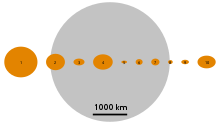9 Metis
- For the moon of Jupiter, see Metis (moon).
| Discovery | |
|---|---|
| Discovered by | A. Graham |
| Discovery date | April 25, 1848 |
| Designations | |
| 1974 QU2 | |
| Main belt | |
| Orbital characteristics | |
| Epoch July 14, 2004 (JD 2453200.5) | |
| Aphelion | 400.548 Gm (2.678 AU) |
| Perihelion | 313.556 Gm (2.096 AU) |
| 357.052 Gm (2.387 AU) | |
| Eccentricity | 0.122 |
| 1346.815 d (3.69 a) | |
Average orbital speed | 19.21 km/s |
| 274.183° | |
| Inclination | 5.576° |
| 68.982° | |
| 5.489° | |
| Physical characteristics | |
| Dimensions | 235×195×140 km[1][2] |
| Mass | ~9×1018 kg |
Mean density | ~2.7 g/cm³[3] |
| ~0.070 m/s² | |
| ~0.11 km/s | |
| 0.2116 d (5.078 h)[4] | |
| Albedo | 0.243 (geometric)[5] |
| Temperature | ~173 K max: 282 K (+9° C)[6] |
Spectral type | S-type[7] |
| 8.1[8] to 11.83 | |
| 6.28 | |
| 0.23" to 0.071" | |
9 Metis is one of the biggest main belt asteroids. It is made of silicates and metallic nickel-iron, and may be the core remnant of a big asteroid that was destroyed by an ancient collision.[9]
Discovery and naming
[change | change source]
Metis was found by Andrew Graham on April 25, 1848; it was his only asteroid discovery.[10] It is also the only asteroid to have been found as a result of observations from Ireland. Its name comes from the mythological Metis, a Titaness and Oceanid, daughter of Tethys and Oceanus.[11] The name Thetis was also considered and rejected (it would later devolve to 17 Thetis).
Characteristics
[change | change source]Metis' direction of rotation is unknown at present.
Hubble space telescope images[2][12] and lightcurve analyses[1] are in agreement that Metis has a non-spherical stretched shape with one pointed and one broad end.[1][12] Radar observations suggest the presence of a significant flat area,[13] in agreement with the shape model from lightcurves.
What the surface is made of has been estimated as 30-40% metal-bearing olivine and 60-70% Ni-Fe metal.[9]
Light curve data on Metis led to an assumption that it could have a moon. However, subsequent observations failed to confirm this.[14][15] Later searches with the Hubble Space Telescope in 1993 found no moons.[12]
Occultations
[change | change source]Metis has been seen to occult stars no less than 5 times.[16]
References
[change | change source]- ↑ 1.0 1.1 1.2 J. Torppa et al., Shapes and rotational properties of thirty asteroids from photometric data Archived 2015-11-06 at the Wayback Machine, Icarus Vol. 164, p. 346 (2003).
- ↑ 2.0 2.1 A. D. Storrs et al., A closer look at main belt asteroids 1: WF/PC images, Icarus Vol. 173, p. 409 (2005).
- ↑ G. A. Krasinsky et al., Hidden Mass in the Asteroid Belt, Icarus, Vol. 158, p. 98 (2002).
- ↑ "PDS lightcurve data". Archived from the original on 2006-06-14. Retrieved 2007-12-17.
- ↑ "MSX Infrared minor planet survey (at PDS)". Archived from the original on 2005-02-17. Retrieved 2007-12-17.
- ↑ L. F. Lim et al., Thermal infrared (8 – 13 µm) spectra of 29 asteroids: the Cornell Mid-Infrared Asteroid Spectroscopy (MIDAS) Survey, Icarus Vol. 173, p. 385 (2005).
- ↑ "asteroid lightcurve data file (March 2001)". Archived from the original on 2010-01-17. Retrieved 2007-12-17.
- ↑ Donald H. Menzel and Jay M. Pasachoff (1983). A Field Guide to the Stars and Planets (2nd ed.). Boston, MA: Houghton Mifflin. p. 391. ISBN 0-395-34835-8.
- ↑ 9.0 9.1 M. S. Kelley and M. J. Gaffey, 9 Metis and 113 Amalthea: A Genetic Asteroid Pair, Icarus Vol. 144, p. 27 (2000).
- ↑ Graham, A.; New Planet, Monthly Notices of the Royal Astronomical Society, Vol. 8, No. 6 (dated April 14, 1848!), p. 146 (signed April 29, 1848; the discovery was first announced on April 27)
- ↑ Graham, A.; Metis, Monthly Notices of the Royal Astronomical Society, Vol. 8, No. 7 (dated May 12, 1848), pp. 147 – 150)
- ↑ 12.0 12.1 12.2 "Hubble Space Telescope observations" (PDF). Archived from the original (PDF) on 2008-10-30. Retrieved 2007-12-17.
- ↑ D. L. Mitchell et al., Radar Observations of Asteroids 7 Iris, 9 Metis, 12 Victoria, 216 Kleopatra, and 654 Zelinda, Icarus Vol. 118, p. 105 (1995).
- ↑ research at IMCCE Archived 2002-06-12 at the Wayback Machine (in French)
- ↑ "other" reports of asteroid companions
- ↑ W. M. Kissling et al., The diameter of (9) Metis from the Occultation of SAO 190531, Proceedings of the Astronomical Society of Australia Vol 9, p. 150 (1991).
Other websites
[change | change source]- shape model deduced from lightcurve Archived 2015-11-06 at the Wayback Machine
- "Notice of discovery of Metis", MNRAS 8 (1848) 146
- Irish Astronomical History: Markree Castle Observatory and The Discovery of the Asteroid Metis Archived 2004-08-23 at the Wayback Machine
- Yeomans, Donald K. "Horizons system". NASA JPL. Retrieved 2007-03-20. — Horizons can be used to obtain a current ephemeris.
